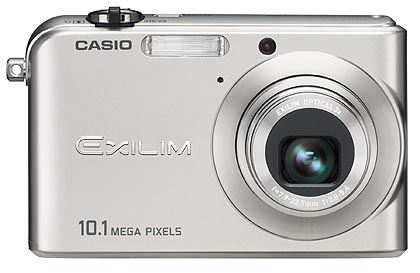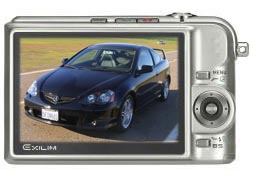|
Casio Exilim EX-Z1000
What's it like to have a 10 megapixel compact?
(by Conrad H. Blickenstorfer)
When the Casio Exilim EX-Z1000 was announced in April of 2006, it was the world's first ten megapixel compact camera. It seemed like only yesterday when the one megapixel barrier had been broken, and now there was an inexpensive little point & shooter that had TEN. Did Casio set the world aflame with this impressive feat? I mean, 10 megapixel is surely a milestone, a nice round number, and an incredible accomplishment. And Casio has always had a flare for creating jewel-like marvels that people loved simply because they looked so sleek and sexy.
Interestingly, as it turned out, the Z1000 became a bit of a missed opportunity. It's a great camera, don't get me wrong, and we thoroughly enjoyed shooting with it over the past eight months or so, but it did not
become a mega hit. What happened?

What you get with the Exilim EX-Z1000 is an amazingly small camera that can take 10-megapixel pictures. That's 3648 x 2736 pixels. To put that in perspective, even a giant 1600 x 1200 pixel display could show
less than a fifth of one of this Casio's pictures. As for printing, even if you print at a very high 250 pixel per inch resolution (200 is usually more than good enough), you could easily run 14 x 11 inch enlargements if you had a printer capable of doing that. Casio claims "poster size" prints from the 10-megapixel mode, and that is not an exaggeration.
And all that from a camera that has a footprint of 3.6 x 2.3 inches -- just a
little larger than a credit card -- and is less than 0.9 inches thick. And even with its fairly powerful battery in place, the Z1000 weighs just six ounces flat. While that makes it a bit thicker and heavier than the sleekest ultra-slims, like Casio's own Exilim S600 and S770, the Z1000 easily fits into any pocket. Especially since the
3X optical zoom lens recedes flush into the camera's body and there are no protrusions of any kind.
There is more good stuff. Like almost all Casios, the Z1000 sports a sleek, elegant all-metal design that perfectly combines ergonomics, good looks and everyday functionality. And unlike some of the stylistic nightmares out there, Casio's designers allways apply good taste and common sense. Everything is clean, elegant and simply works. Sure, like everyone else, Casio mixes colors, icons and text to mark and label all the controls, but does so with a minimum of confusion and a maximum of clarity.
Large LCD display
Like most small digital cameras, the Z1000 no longer has an optical viewfinder, which means you have to rely on the LCD at all time. Fortunately, the Z1000 has an excellent one. It measures 2.8 inches diagonally, uses the increasingly common "wide" format, and is razor-sharp thanks to 230k pixels, which translates into a 960 x 240 screen resolution. The large screen can be put to good use in several ways. The Z1000 let's you select a special 16:9 aspect ratio "HDTV" format. Or you can use the standard 4:3 format and then run a very handy vertical menu bar across the left edge of the display.
Handy controls
In terms of controls, you don't need to spend hours perusing the Casio's manual in order to figure out how it works (which is a good thing as the printed manual is a very basic 7-language affair and you need to resort to the electronic PDF version on the CD for details).
On top there's a small, recessed on/off button, the shutter surrounded by a zoom ring, small red and green marked buttons to put the camera into playback and recording mode, and an equally small DISP button that brings up a screen menu with four tabs where you can set the panel size, determine what information you want to see on the screen, set its brightness, and even pick one of five display settings (like a vivid one, one for night and so on).
The back is mostly taken up by the large LCD, and so the only controls there are a small four-way navigation disk with a SET button in the middle
and a couple of small tabs. Unlike most current cameras, Casio didn't assign a lot of extra functions to the four directions of the navigation disk.  Push down to bring up the flash mode menu, up to toggle between digital zoom on and off. Everything else is set via on-screen menus. The only other hardware controls are a MENU button and the somewhat awkwardly named "BS" button. That stands for "Best Shot" and allows you to pick from no fewer than 36 modes. Those 36 modes include everything from standard shooting to movies to voice recording to any number of settings. Some make perfect sense with special settings for the likes of Sports, Candelight Portrait, Natural Green, Autumn Leaves, Soft Flowing Water, Sundown and do on. There are specialty modes like shooting text, optimized settings for eBay pictures, and flash back-fill. Others apply filters, like what you could do later in an imaging program: monochrome, sepia, watercolor, pastel, and so on. Push down to bring up the flash mode menu, up to toggle between digital zoom on and off. Everything else is set via on-screen menus. The only other hardware controls are a MENU button and the somewhat awkwardly named "BS" button. That stands for "Best Shot" and allows you to pick from no fewer than 36 modes. Those 36 modes include everything from standard shooting to movies to voice recording to any number of settings. Some make perfect sense with special settings for the likes of Sports, Candelight Portrait, Natural Green, Autumn Leaves, Soft Flowing Water, Sundown and do on. There are specialty modes like shooting text, optimized settings for eBay pictures, and flash back-fill. Others apply filters, like what you could do later in an imaging program: monochrome, sepia, watercolor, pastel, and so on.
Interestingly, Casio placed "anti-Shake" into this big mix of modes as well. You can select it and it stays selected until you pick another mode. This is
not a "real" anti-shake that actually monitors movement and steadies the CCD, but a digital version which reduces blur via a combination of faster shutter speed and increased sensitivity. That can work quite well under some circumstances, but may result in grainier pictures in lower light situations.
Why did Casio not go all out?
So now that I pointed out most of the good stuff about the Exilim E-Z1000, let me express a bit of puzzlement. See, the big question this camera raises is why Casio created the first 10-megapixel compact -- quite obviously a milestone and landmark -- but then sort of left it at that. The Z1000 is certainly a nice camera, but it isn't special in the way it could have been. Compared to several other current
Casios, and especially the S600 and S770, it looks a bit boring and basic. And it's actually missing some of the extra-cool stuff that adds fun, value and excitement to those "lesser" Casios. For example, most current models in Casio's lineup have a "past movie" mode where the camera quietly records while you follow a game or wait for some event to happen. When it does, you push the shutter and the camera commits the eight seconds PRIOR to the event to storage and keeps recording. It's brilliant. And missing from the Z1000. And for some inexplicable reason, the Z1000 records movies at 25 frames per second, and not 30, as is the norm. And the optical zoom, certainly not high on our list, but still, the Z1000's maxes out at 4X, less than some of its brethrens'. Oh, and no MPEG4 movie encoding.
You get the picture -- it's as if Casio tried so hard to have the first 10-megapixel camera that it cut corners in the process of getting there, leaving out things that its own lower end models have. Casio seems to know that, too, as the Z1000, even according to Casio's own website, has the same US$349 street price as the Z850 and the S770.
And Pricescan.com
shows that the
average selling price of the Z1000 is below that of the Z850 and S770.
Still, an excellent value
So we're not quite sure what Casio had in mind when it created the Z1000. A landmark achievement for sure, but not the stunning, crowning home run it could have been. The good news is that because of that, the Z1000 is amazingly affordable, and you do get a lot for your money. It's not the instant conversation piece the sexy S600 and S770 are, unless you run into techies who appreciate the ultra-high resolution. But you do get that terrific resolution that lets you crop to your heart's content and always end up with plenty enough pixels, you do get a terrific 2.8-inch display, you do get a friendly camera that stows away anywhere and is never in the way, and you get excellent technology, speed, and picture quality. So if you can live with the
relative lack of pizzazz and don't fret over the movie mode ommissions, the Z1000 will most definitely not disappoint.
We like:
- 10.1 megapixel resolution
- Terrific 2.8-inch wide LCD
- 36 different modes
- Very good battery life
- Small and handy
Not so much:
- Strangely subdued for the first 10 megapixel compact
- Scratches easily
- Cool "past movie" mode of other Casios is missing
- 25 fps frame rate not quite lifelike, and no MPEG4
|








